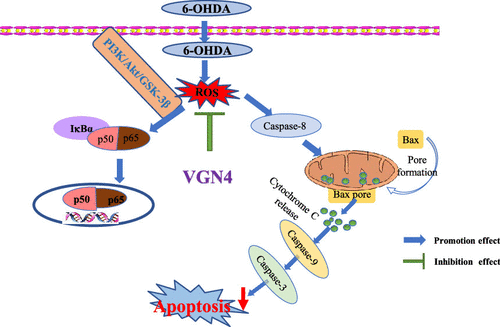当前位置:
X-MOL 学术
›
J. Agric. Food Chem.
›
论文详情
Our official English website, www.x-mol.net, welcomes your
feedback! (Note: you will need to create a separate account there.)
Vina-Ginsenoside R4 from Panax ginseng Leaves Alleviates 6-OHDA-Induced Neurotoxicity in PC12 Cells Via the PI3K/Akt/GSK-3β Signaling Pathway
Journal of Agricultural and Food Chemistry ( IF 5.7 ) Pub Date : 2020-12-08 , DOI: 10.1021/acs.jafc.0c06474 Yanyan Luo 1, 2 , Yunyao Jiang 3 , Yang He 1 , Ting Shen 1 , Lilian Ji 1 , Fu Li 2 , Weicheng Hu 1
Journal of Agricultural and Food Chemistry ( IF 5.7 ) Pub Date : 2020-12-08 , DOI: 10.1021/acs.jafc.0c06474 Yanyan Luo 1, 2 , Yunyao Jiang 3 , Yang He 1 , Ting Shen 1 , Lilian Ji 1 , Fu Li 2 , Weicheng Hu 1
Affiliation

|
Vina-ginsenoside R4 (VGN4) is the first example of protopanaxatriol saponin possessing sugar chains located at C-3 and C-20 of aglycone. However, to the best of our knowledge, no report has been published on the neuroprotective effect of VGN4. In the present work, we investigated the neuroprotective effect of VGN4 against 6-hydroxydopamine (6-OHDA)-induced toxicity and its potential mechanism. Pretreatment of PC12 cells with VGN4 attenuated 6-OHDA-induced cell damage and cell apoptosis, which was correlated with the decrease of reactive oxygen species and the increase of antioxidant enzyme activities including superoxide dismutase and catalase. In addition, VGN4 markedly decreased nuclear translation of the nuclear factor-κB and PI3K/Akt/GSK/3β signaling pathway including p85, PDK1, Akt, and GSK-3β. Further studies revealed that PI3K siRNA attenuated the neuroprotective effect of VGN4 on caspase-3 activity. These data indicate that VGN4 might have the potential to be developed as a new neuroprotective functional food.
中文翻译:

人参叶中的人参皂苷R4通过PI3K / Akt /GSK-3β信号通路减轻PC12细胞中6-OHDA诱导的神经毒性
人参皂甙R4(VGN4)是具有位于糖苷配基的C-3和C-20处的糖链的原托泊三醇皂苷的第一个实例。然而,据我们所知,尚未发表有关VGN4的神经保护作用的报告。在目前的工作中,我们调查了VGN4对6-羟基多巴胺(6-OHDA)诱导的毒性的神经保护作用及其潜在机制。用VGN4预处理PC12细胞可减轻6-OHDA诱导的细胞损伤和细胞凋亡,这与活性氧的减少和抗氧化酶活性(包括超氧化物歧化酶和过氧化氢酶)的增加有关。此外,VGN4显着降低了核因子-κB和PI3K / Akt / GSK /3β信号通路(包括p85,PDK1,Akt和GSK-3β)的核翻译。进一步的研究表明,PI3K siRNA减弱了VGN4对caspase-3活性的神经保护作用。这些数据表明VGN4可能有潜力被开发为一种新型的神经保护功能性食品。
更新日期:2020-12-23
中文翻译:

人参叶中的人参皂苷R4通过PI3K / Akt /GSK-3β信号通路减轻PC12细胞中6-OHDA诱导的神经毒性
人参皂甙R4(VGN4)是具有位于糖苷配基的C-3和C-20处的糖链的原托泊三醇皂苷的第一个实例。然而,据我们所知,尚未发表有关VGN4的神经保护作用的报告。在目前的工作中,我们调查了VGN4对6-羟基多巴胺(6-OHDA)诱导的毒性的神经保护作用及其潜在机制。用VGN4预处理PC12细胞可减轻6-OHDA诱导的细胞损伤和细胞凋亡,这与活性氧的减少和抗氧化酶活性(包括超氧化物歧化酶和过氧化氢酶)的增加有关。此外,VGN4显着降低了核因子-κB和PI3K / Akt / GSK /3β信号通路(包括p85,PDK1,Akt和GSK-3β)的核翻译。进一步的研究表明,PI3K siRNA减弱了VGN4对caspase-3活性的神经保护作用。这些数据表明VGN4可能有潜力被开发为一种新型的神经保护功能性食品。































 京公网安备 11010802027423号
京公网安备 11010802027423号